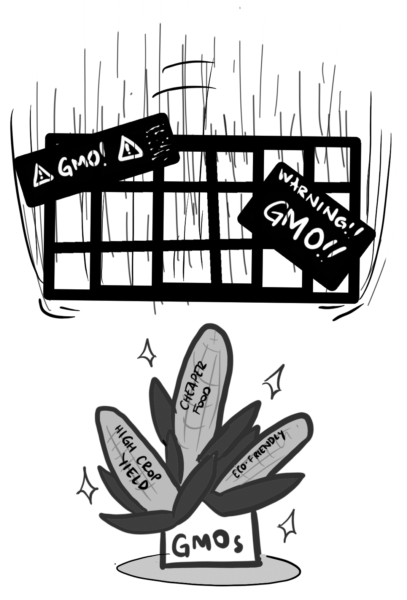
Genetically modified organisms, or GMOs, have brought countless blessings upon humanity. They protect crops from pests, which reduces the need for pesticides, improves nutrition and will help feed a growing population.
However, even though trusted scientific institutions, such as the Food and Drug Administration, American Medical Association andWorld Health Organization, have all concluded that GMO foods pose no threat to human health, many still hold the putative belief that GMOs are harmful and humans should stop genetically modifying organisms.
A large part of the problem is food labeling — many labels simply warn against the dangers of genetically modified organisms. Many wholesale markets, such as Whole Foods, require GMO products to be labeled. But although the labels are saturated with negative claims regarding GMOs, there is no mention of the positives. This, combined with the proliferation of ominous advertisements that imply the supposed deadliness of genetically modified organisms, creates an anti-GMO movement that is based on fear, not facts.
Granted, there is some risk to using genetically modified organisms commercially. One is gene transfer, or the transfer of genes from one organism to another. The transfer of herbicide-resistant genes from modified plants to weeds could create super-weeds resistant to herbicides. However, studies have shown that the chance of gene transfer is incredibly low and therefore poses no risk to human health.

Another point of concern are the herbicides and pesticides themselves. If a plant is genetically engineered to synthesize its own pesticides, wouldn’t that mean that the plant immediately becomes toxic to humans? Not necessarily. Just as chocolate is toxic to dogs but not humans, pesticides produced by genetically modified plants are toxic to insects, but not to humans.
The antipathy toward GMOs is a problem. As long as misinformation is spread, GMO’s benefits could remain unavailable to us. As the world’s population increases, the demand for nutrition increases, but space for agricultural output remains relatively the same. With genetically modified organisms, we can intensify crop output instead of clearing more areas for agricultural use. This not only allows us to support the human population, but it also reduces our environmental footprint.
There are various other examples of the good that genetically modified organisms have done. Many developing nations are crippled with vitamin A deficiency, which increases susceptibility to infection and can cause blindness. In order to combat this issue in Asia, scientists created golden rice, a variant of rice which is capable of producing its own vitamin A. One bowl of this rice provides a child with 60 percent of daily-needed vitamin A.
GMOs already surround us. According to a Los Angeles Times article, 70 to 80 percent of commercial foods are already genetically modified. The next time you purchase a snack from a school vending machine, read the fine print. Chances are, it will say “partially produced with genetic engineering” somewhere in there. GMOs also pop up in unexpected places. The popular spicy chicken strips on the lunch menu at Aragon? Those chickens were raised on feed made from commodity corn, which was genetically modified through selective breeding.
The fear surrounding genetically modified organisms is blown out of proportion. Anti-GMO campaigns, which are fueled by fear and not scientific evidence, only serve to hurt humanity. Humanity might soon arrive at a point at which it is unethical not to use genetically modified organisms. Is our comfort in eating organic foods really worth having when we can use genetically modified organisms to help solve world hunger, malnutrition and support farmers?



